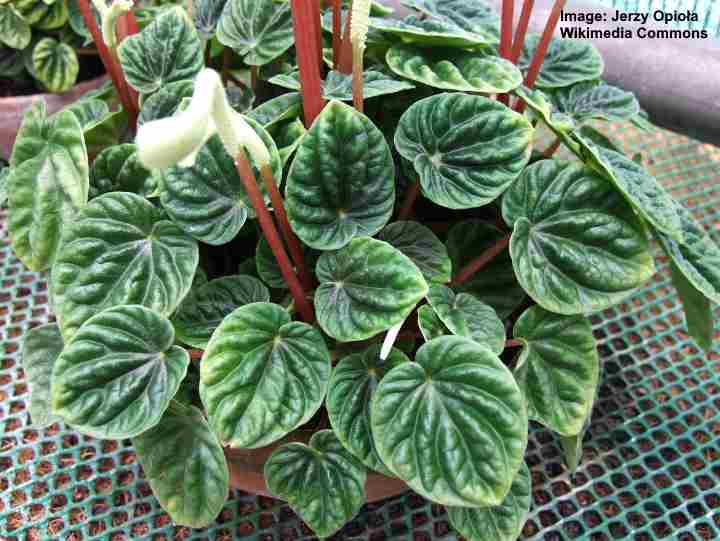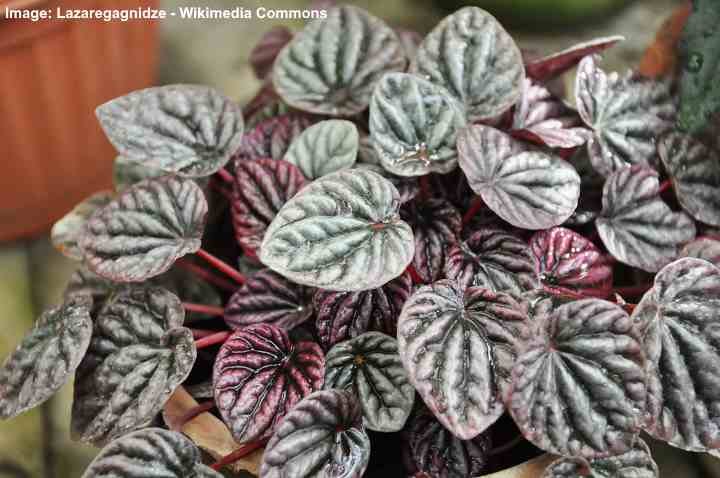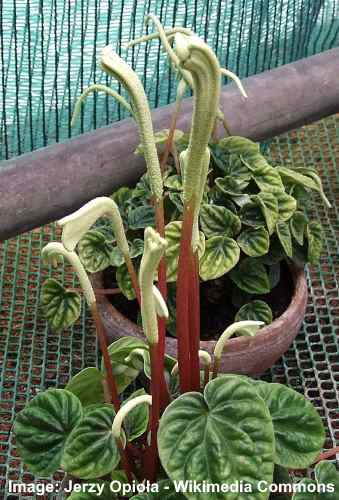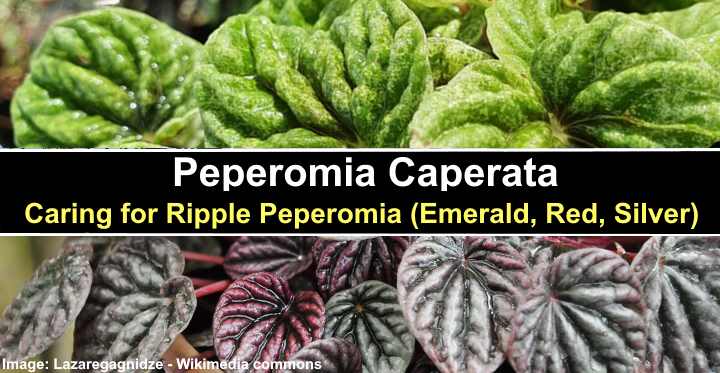The Ripple Peperomia, also known as Peteromia caperata, is a metallic sheen wrinkled, heart-shaped plant that blooms throughout the year. Silver, red, or rich green are some of the hues available in ripple peperomias. Emerald Ripple Peperomia, with its lustrous, dark green deeply puckered leaves and compact growth, is a popular species of Peperomia caperata.
The emerald ripple peperomia (Peperomia caperata) is a complete care guide that includes everything you need to grow it. You’ll discover out about additional magnificent varieties of ripple peperomia plants in addition to practical advice on caring for this lovely indoor plant.
How to Care for Peperomia Caperata
Grow the Perperomia caperata in bright, indirect sunlight, a porous well-draining potting soil, and average room temperatures and humidity to care for a ripple peperomia. Watering the plant when the soil is mostly dry is ideal. During the growing season, feed ripple peperomia houseplants diluted houseplant fertilizer monthly.
About Peperomia Caperata (Ripple Peperomia)
A tropical blooming perennial from Brazil’s rainforests, the ripple peperomia is a unique plant. It’s a clump-forming evergreen plant that thrives in the forest floor’s shady patches. Tropical climates’ warm, humid conditions promote the development of healthy, lush plants. The genus Peperomia and family Piperaceae include the plant Peperomia caperata (ripple peperomia). Peperomia varieties come in over 1,000 different species, some of which are treasured as foliage plants.
Ripple peperomia is a small houseplant that only grows to be 8 inches (20 cm) tall. The glossy, thick heart-shaped leaves have a wrinkled or puckering look and are one of its attractive features. The plant’s attractive properties are further enhanced by spiked flowers (inflorescence).
The peperomia caperata is a semi-succulent plant, like other peperomia species. Emerald ripple peperomias need to be grown in a light, aerated potting medium with access to oxygen and moisture because of its epiphytic roots. Radiator plants are another name for plants in the Peperomia genus. Peperomia plants thrive in warm air and sunlight, hence the common name. Indoor plants, on the other hand, flourish in both shade and drier climates.
Green ripple peperomia, ivy-leaf peperomia, metallic peperomia, and silver heart are some of the names for Peperomia caperata. It is cultivated as a houseplant in temperate areas since the emerald ripple peperomia does not tolerate temperatures below 50°F (10°C).
Types of Peperomia Caperata (Ripple Peperomia)
Thousands of peperomia species exist, including Ripple peperomia. There are several stunning cultivars of Peperomia caperata, however. Ripple peperomia comes in a variety of shapes and sizes, and they’re worth investigating.
Peperomia caperata ‘Emerald’ (Emerald Ripple Peperomia)

The bushy compact growth of Peperomia caperata ‘Emerald’ Its heart-shaped leaves feature deeply puckered veins and are dark green in color. The ends of red stems of emerald ripple peperomias also have white blooming spikes.
Peperomia caperata ‘Ripple Red’ (Red Ripple Peperomia)

Heart-shaped crinkled leaves with iridescent burgundy red coloration adorn Peperomia caperata ‘Ripple Red.’ This epiphytic houseplant has an exotic appearance thanks to the metallic corrugated peperomia leaves. This 8″ (20 cm) tall and wide mound-forming peperomia thrives.
Peperomia caperata ‘Silver Ripple’ (Silver Peperomia)
Silvery corrugated cordate (heart-shaped) leaves adorn the silver ripple peperomia. Its tinged green and silver leaves, as well as a silver sheen, are seen on some specimens.
Peperomia caperata ‘Rosso’

The peperomia ‘Rosso,’ which has lance-shaped, somewhat grooved leaves, is an uncommon variant of Peperomia caperata. The upper surfaces of the lanceolate pointed leaves are rich green, while the underneath surfaces are maroon. Peperomia ‘Rosso’ is a yellowish-green blooming epiphytic houseplant with tiny red stems that bears yellowish-green blooms.
The pink and green Peperomia caperata ‘Pink Lady’ and the dark green and red Peperomia caperata ‘Teresa’ are two other lovely examples of variegated ripple peperomia cultivars.
Ripple Peperomia Leaves
The heart-shaped, wrinkled leaves of Peperomia caperata are its most distinguishing feature. The leaves have a ‘space-age,’ exotic appearance due to the puckered black veins contrasting with the raised ridges and metallic sheen. The ripple peperomia is an ideal indoor plant for homes or offices due to its dense, compact evergreen leaf growth.
Cordate, with a corrugated surface and impressed veins, is how ripple peperomia leaves are described. The leaves grow on the ends of 3-inch (7.5-cm) petioles (stems) and are between 1″ and 3″ (2.5 – 7.5 cm).
Ripple Peperomia Flower

White flower spikes called inflorescences develop on the ends of red stems, and Peperomia caperata blooms are white. Creamy-white blooms are common. Ripple peperomia plants bloom in the summer and autumn, depending on the growing conditions. Ripple peperomia blooms have modified colorful leaves that look like stamens on arum lilies.
How to Care for Ripple Peperomia (Peperomia caperata)
To ensure the lovely waxy leaves keep their glossy, ripple look, let’s take a closer look at how to care for Peperomia caperata at home.
Peperomia caperata Light Requirements
Emerald ripple peperomia prefers filtered light, but it can tolerate direct sun if necessary. In a bright room, the plant thrives on an east-facing windowsill. It’s best to filter sunlight through a sheer curtain near a south- or west-facing window. The waxy peperomia leaves can become dull due to intense direct sunlight.
Ripple peperomia plants thrive in low-light situations. These plants thrive in gloomy spots like bedrooms and north-facing spots. If radiator plants like the Ripple Peperomia stay in the dark for too long, they may start to lose their foliage color. Move the plant to a brighter area if this occurs.
As a tabletop office plant, any species of Peperomia caperata is appropriate. Fluorescent lights are ideal for the emerald peperomia, ripple red peperomia, and silver ripple peperomia.
The Best Soil for Growing Peperomia caperata
Ripple peperomia prefers rich, aerated, loamy potting soil with excellent drainage. Two parts peat moss, one part horticultural sand, and one part perlite are ideal for a peperomia soil mix. Some moisture should be retained in the best growing medium, but water should flow freely.
An epiphytic plant like Peperomia caperata requires air and moisture for nutrients. Peperomias may be grown in commercial potting soil, which can then be amended with gravel, perlite, or orchid bark to improve drainage. Between irrigations, the peperomia soil should dry out quickly.
Emerald ripple peperomia plants are sensitive to wet, soggy soil, which is something to keep in mind. Always make sure that the potting soil is not drowning. The peperomia’s growth, on the other hand, will be influenced by dry soil.
How to Water Ripple Peperomia (Peperomia caperata)
The most important attention factor for cultivating this toughy houseplant is watering it properly. Only when the top 2 to 3 inches (5 to 7.5 cm) of the potted peperomia is dry should you water it. Then, until the soil drains through the pot’s drainage holes, thoroughly douse it with room-temperature filtered water.
In the spring and summer, you may have to water an emerald ripple peperomia every week. You may only need to water the bushy houseplant every two or three weeks in the winter. Make sure the top layer of soil is dry before watering a peperomia.
At home, Emerald Ripple Peperomia is a breeze to take care of. The plant can thrive with little water and is drought tolerant. Watering houseplants—including ripple peperomia—should be done by soaking the soil and then letting it dry between watering. Since the roots are constantly moist without becoming soggy, this watering technique ensures healthy growth.
Temperature Range for Peperomia caperata Houseplants
In typical room temperatures, the ripple peperomia thrives. Between 65°F and 80°F (18°C and 26°C), it prefers to live. Never allow the temperature to drop below 50°F (10°C) because peperomias are native to tropical climates. Ripple peperomia generally thrives at a temperature of about 70 degrees Fahrenheit. There are a few things to be careful of when growing Ripple
Peperomia at home, even if the average home temperatures are ideal.
Drafts from open windows and air conditioning systems, for example, may harm the plant’s development. While the ripple peperomia is a hot air vent or furnace plant, growing alongside it can stress the plant and cause its leaves to wilt, despite the fact that it is a radiator plant.
Humidity Requirements to Grow Peperomia caperata Indoors
In medium to low humidity, the ripple peperomia thrives. You don’t have to be concerned about humidity levels in typical home situations. Potted houseplants tolerate home humidity levels, despite the fact that this tropical rainforest plant thrives in humid climates.
Keep the leaves of Peperomia caperata damp by misting them. To moisten them and remove dust from the leaves, you can wipe them with a damp cloth once a week. You may put the ripple peperomia on a pebble tray full of water if your home has particularly dry air.
How to Fertilize Peperomia caperata for Healthy Growth
Ripple peperomia isn’t a particularly hungry plant. Throughout the growing season, you just have to apply a diluted houseplant fertilizer once a month. The corrugated, ridged leaves will stay looking their best if you feed them more during the spring and summer. Ripple peperomia varieties may thrive on their own if they are not fed regularly. In most situations, simply watering a ripple peperomia when the soil dries is the best way to care for it.
Peperomia caperata Growth Rate
Slow growers include all types of peperomia, especially emerald ripple peperomia. A ripple peperomia grows to 8″ (20 cm) tall and has a spread of up to 8″ (20 cm) under ideal conditions. Filtered light and partly moist soil are ideal for growing the Peperomia caperata.
Pruning Ripple Peperomia
Pruning Peperomia caperata is not usually required. Without having to prune the leaves, this mound-forming peperomia develops a natural bushy, rounded growth. If the ripple peperomia stems have become leggy or show signs of deterioration, you may snip them off.
How to Propagate Peperomia caperata
Stem or leaf cuttings are the most effective way to propagate Ripple peperomia. Peperomia plants root readily in a well-draining potting medium, as do many succulents. Even though fallen leaves may take root in the soil, Cut a few healthy leaves and stems from a ripple peperomia to propagate it.
For a day or two, leave it on a paper towel to dry. Next, put the stem in a loose, moist potting soil so that the leaf is in contact with the soil.
Leave the soil slightly moist and cover with plastic in a bright location. You should notice new plants growing from the propagated peperomia leaf’s base after four to eight weeks.
How to Repot Ripple Peperomia
The roots of Peperomia caperata may benefit from repotting, which allows them to expand properly. Ripple peperomia plants, on the other hand, don’t need to be repotted very often; two or three years is usually sufficient. It’s also a good idea to refresh the potting soil after repotting a peperomia.
Choose a pot one size bigger than the current one before repotting the ripple peperomia. Remove the plant from its existing container gently. Remove any dead, mushy roots and shake off any excess soil. Place the peperomia in its new pot, filling it halfway with an suitable potting material, and ensure it grows at the same height as before. Place the soil in a sunny, draft-free area to get the best growth if you haven’t watered it thoroughly.
Pests Affecting Peperomia caperata Growth
Common houseplant pests and bugs aren’t particularly damaging to the ripple peperomia. Mealybugs, aphids, and spider mites are uncommon problems with a healthy Peperomia caperata. Keeping pests at bay is simple: keep peperomia plants in bright, filtered sunlight and only water when needed.
If you notice any signs of aphids, mealybugs, or spider mites, treat the plant’s leaves with a neem oil solution. Mix 2 tsp. neem 1 tsp. oil and 1 tsp. salt A spray canister should be used to make dish soap with 1 quart (1 l) of warm water. Apply neem oil to both sides of the leaves using a cotton ball. To get rid of houseplant pests, use a natural pesticide every week.
Diseases affecting Peperomia caperata Growth
The disease resistant ripple peperomia care recommends that you avoid any diseases that might harm the plant. Weak growth, mushy black stems, and plant mortality are common symptoms of potting soil moisture problems with a Peperomia caperata. To avoid Ripple Peperomia illness, follow the following care instructions:
- Ripple peperomia should never be overwatered.
- Because water drains poorly, avoid the plant from becoming root-bound.
- To avoid dampness and mold, keep the peperomia plant in a warm, bright location.
- In a loose, porous, aerated potting mix, always grow Peperomia caperata.
Is Peperomia caperata Toxic
Cats and dogs are not poisonous to the emerald ripple peperomia plant. On the non-toxic houseplants list from the ASPCA, Peperomia caperata is listed.
FAQs About Peperomia Caperata Care
In most cases, indoor care of emerald ripple peperomia plants is simple. A peperomia houseplant may be stressed, however, if a few symptoms appear. For addressing some care concerns, here are some good ideas.
Why are my Emerald Ripple Peperomia stems turning black?
Overwatering is frequently indicated by Ripple peperomia stems and leaves turning black. Root rot and nutrient starvation are common problems caused by soggy, overly wet soil. Fungal infections can also harm plant development. Pruning the dead or rotting branches is one way to overcome this issue. Wait until the top layer of soil is completely dry before watering again. Remember to water the peperomia only when the soil is mostly dry.
Why is my Peperomia caperata plant drooping?
This indicates that the soil is too dry if the rippled peperomia leaves are drooping. When the growing medium around the roots is always slightly moist, ripple peperomia plants perform best. Soaking the soil every time you water is the best way to care for peperomia.
What does it mean if ripple peperomia leaves are dull?
Emerald ripple peperomia leaves lose their brilliance when there is insufficient sunlight. Ripple peperomia plants thrives in bright, indirect sunlight and are adaptable to low-light conditions. Move the compact houseplant to a brighter spot if the formerly glossy, glossy leaves seem dull.
Why are ripple peperomia leaves turning brown?
If the plant is in a cold draft, the tips of ripple peperomia leaves are commonly browned. Brown tips, on the other hand, may indicate that the plant has gone underwater or that it has been scorched by the sun. As a result, to discover why peperomia leaves are rotting, inspect the plant’s surroundings.
